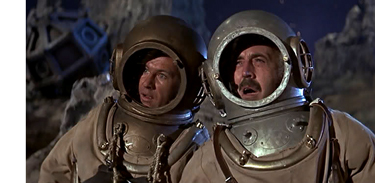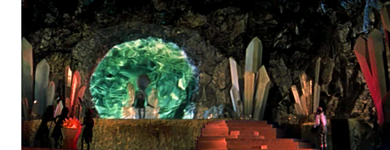
 |
|
|
|
Are we running out of Ray Harryhausen debuts on Blu-ray? Nope, there are few more to go, from RKO, Fox and Warners. A hugely anticipated title is this childhood favorite, that really benefits from the extra boost of HD enhancement. And Twilight Time comes to the rescue in the quality and extras department. 
In conventional terms First Men in the Moon is probably Ray Harryhausen's best-constructed movie. Just as real Gemini & Apollo space missions were making fanciful outer space adventures obsolete, Harryhausen and Charles Schneer came forward with this winning version of H.G. Wells' classic 1901 science fiction novel. Filled with good humor, turn-of-the-century charm and awesome imagery, it has a first-rate script by English Quatermass creator Nigel Kneale, who succeeds in updating the original story yet leaves most of it as a period piece. The casting makes excellent use of the underrated Lionel Jeffries as Wells' endearingly daffy inventor of a flubber-icious goo that 'severs the magnetic ties of gravitation'. Charles Schneer's London-based production is first rate. Back in Victorian 1896, wastrel Arnold Bedford (Edward Judd) is too impatient to write plays in his rented cottage but sharp enough to string along lovely Kate Callender (Martha Hyer), a fine woman he doesn't deserve. Keenly attuned to get-rich-quick schemes, Bedford become excited when his neighbor, eccentric inventor Joseph Cavor (Lionel Jeffries) shows him the antigravity paste he's invented. Fired up with the spirit of adventure (and evading his creditors), Bedford joins Cavor on an expedition to the Moon, with Kate becoming an inadvertent 11th-hour stowaway. The three zoom across the heavens to the Moon's dead surface... only to discover an entire alien civilization thriving in its cavernous interior.
H.G. Wells really hit his stride with his book First Men In the Moon. Of all his early science fiction work it's the most readable and fleshed-out. Told from Bedford's point of view, the narrative flows as a semi-surreal fever dream, with Bedford trying his best to accurately describe one incredible situation after another. Wells' description of zero
Savant was just old enough to be critical about movies when this matinee favorite hit the theaters. You can bet I was the first kid in line. The book was one of my favorites (ditto the excellent Classics Illustrated comic). I was concerned to learn that the story had been changed to include a girl on the voyage. There was nothing to fear. The film has a much lighter tone than the book. Martha Hyer's welcome stowaway does not interfere with the adventurous goings-on, if only because she remains locked in the sphere a good part of the time. The book's strange depiction of lunar weightlessness is missing, but from the moment the Englishmen encounter the spear-carrying Selenites on the underground cliffs, I knew the show was on the right track. The more literate will notice that little was retained of Wells' thesis about a biologically regimented society. The sociological messages in his The Time Machine and The Island of Dr. Moreau were mostly ignored as well. Laurie Johnson's socko music score kicks off an arresting title sequence combining views of the moon with graphics of rippling water reflections. The drama begins in a 'quaint' period setting familiar from earlier Wells and Jules Verne adaptations like The Time Machine and Journey to the Center of the Earth. But as soon as Cavor's capsule launches skyward we enter a realm of nonstop special effects, an alien 'landscape plus music' fantasia that doesn't let up until the very end. 
Although we see little of Harryhausen's standard animation techniques compared to his other pictures, his work is fully integrated into the story fabric -- this isn't a series of episodic creature vignettes. A rather disappointing caterpillar creature called the Moon Calf is the only standard monster. Harryhausen instead sells us on the existence of a horde of insectoid creatures that Wells called Selenites. Some are animated with stop-motion but the majority are people in rubber suits (midgets? children?). They work quite well, much better in fact than the children-as-aliens in Steven Spielberg's Close Encounters made only thirteen years later. Harryhausen's self-mummifying intellectual ant leaders are fascinating animated creations... that also predate Spielberg by using electronic devices to communicate with Cavor and Kate. Our two-fisted hero Bedford shuns the idea of talking to bugs. Although most of the moon's interior is excellent miniature work the show uses plenty of impressive full-sized sets. The colorful subterranean world is imaginatively designed, clearly by Ray himself, and perhaps influenced by the old Cooper-Schoedsack epic She (1935). Harryhausen's wavy-glass tricks with the Grand Lunar are mesmerising, as are his bottomless wells and deep galleries of caves. The fairly simple trick of enlarging rows of giant tubes of colored liquid is quite beautiful. The only weak illusion, a very minor point, is a row of stalactite crystals on the stairway to the Grand Lunar that are too clearly flat paintings. For some reason they stick out every time. 
Yes, this is actually Ray's finest film overall. As a showcase for his animation it's not top-rank, but as a movie it's way out front. Kneale would seem a good collaborator with the earnest Harryhausen, who had of course been a science fiction fan since his childhood with Forrest Ackerman and Ray Bradbury. I hope that Harryhausen and Kneale got on well together, as the mental image of them sharing ideas is a pleasant one. Kneale rarely saw his work brought to life with such technical artistry: even the effects of Hammer's superior Quatermass and the Pit are barely adequate. But Kneale gave Ray an even greater gift, a shooting script that added up to much more than a string of monster encounters. The film is billed as produced in Dynamation, but Harryhausen doesn't use his revolutionary rear-projection system much, if at all. The Panavision format made that too difficult. What we see is a lot of compositing done via traveling matte processes, sometimes with two levels of blue-screen matting employed. Harryhausen never worked in an anamorphic format before or since. Proportion and perspective look great in the widescreen shots that combine live action figures with miniature backgrounds. In Germany, First Men In the Moon was blown up to 70mm and marketed as a one-film Cinerama attraction, in stereophonic sound. 
Martha Hyer is both sensible and sympathetic as the girl written into a boy's adventure. Edward Judd (excellent in The Day the Earth Caught Fire) makes for a thickly brash hero. Once on the moon, the irresponsible Bedford becomes a take-charge guy, making for a nice change of tone. Lionel Jeffries' Cavor begins as a silly twit but by the end is revealed as a courageous dreamer who carries the conscience of the human race. We associate Cavor's boyish fervor with a special brand of English hobbyists, that always seem to wear tweeds. Director Michael Powell was said to be this kind of impulsive, buoyant man. Cavor's character has a built-in nostalgia for another time. There may be a bit too much kiddy humor up front ("Madame, please leave the room!" "I hate chickens") but Lionel Jeffries is far too good an actor to throw away any serviceable dialogue line. A moment when he bids farewell to his gaggle of pet geese is very endearing. 
Nigel Kneale and Jan Read's stroke of genius is the application of a wraparound flashback story structure. With the real space program making news every day, Columbia surely feared that Wells' turn-of-the-century story would seem terribly old-fashioned. Kneale cleverly frames his narrative in a flashback from a point in the near future, when a United Nations capsule lands on the moon. As filmed by Nathan Juran (by far Schneer and Harryhausen's best director) these scenes crackle with typical typical Kneale efficiency. The lunar landing is all but identical to the real one that occurred five years later. The script uses a shock cut from astronaut feet touching the lunar surface to a ticker tape parade back home, a cutting masterstroke copied for 1983's The Right Stuff. Columbia's advertising posters cleverly enlisted a real NASA spokesman to endorse the film: "It's out of this world!" Of course, the stinger is that the astronauts discover a desiccated Union Jack on the moon. Someone named Callendar has beaten them to the moon. Once tracked down, the 90 years-plus Arnold Bedford is all too eager to tell his story, now that someone is willing to believe him. The effect is charming - the 'real' space story comes not from Cape Canaveral but an old folks' rest home. Kneale also makes room for a characteristic bit of irony. In his previous Quatermass adventures the alien species we encounter are always a biological mismatch, a deadly threat. In this instance, Kneale works a reversal of that idea, borrowing an idea from H.G. Wells biggest literary hit, The War of the Worlds. |
|||||||||||||||||||
Review Staff | About DVD Talk | Newsletter Subscribe | Join DVD Talk Forum
Copyright © MH Sub I, LLC dba Internet Brands. | Privacy Policy
Subscribe to DVDTalk's Newsletters
|